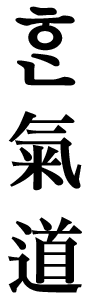Hankido
| Hankido | |
 |
|
| Korean name | |
|---|---|
| Hangul | 한기도 |
| Hanja | 韓氣道 |
| Revised Romanization | Hangido |
| McCune–Reischauer | Hankido |
Hankido is a new martial art style developed by Myung Jae-nam using even more circular flowing movements owing to Myung Jae-nam's background in traditional Korean dance.
The name hankido is a mix of the name Hanguk (the Korean name for South Korea) and hapkido. The resulting word hankido is often written with the han in Old Korean, where the letter "a" (ㅏ) is written as arae-a, which looks like a dot. Hankido aims to be a Korean martial art for and from the Korean people, accessible to everyone. The precise origin of hapkido, from which hankido is derived, is one of many Japan–Korea disputes, as there is a strong connection to the Japanese martial art aikido. "Aikido" is always written in kanji, which are similar to hanja.
The word hankido actually consists of three different hanja:
So you could say that hankido means: The way for Korean people to develop their internal energy/strength.
Hankido is a relatively new hapkido style, developed by Myung Jae Nam. Myung Jae Nam studied traditional hapkido which formed the basis of this new art. Myung Jae Nam started the development of what we now know as hankido in the 1980s. This new hapkido style can be recognized by its elegant, circular movements which the hankido practitioner uses to get in control of his or her opponent. Of course this is partly because hankido has its roots partly in hapkido, but also because Myung Jae Nam, who was a talented dancer, mixed the techniques with traditional Korean dance. This part of hankido is called: Moo Yae Do Bub (무예도법).
Hankido was first officially introduced during the 1st International H.K.D Games in Seoul, South Korea. The development of hankido did not stop there, and in the years after its introduction hankido lost some of its rough edges. In 1993 the IHF trademarked the name hankido in both hangul and hanja writing in South Korea for the first time.
...
Wikipedia
